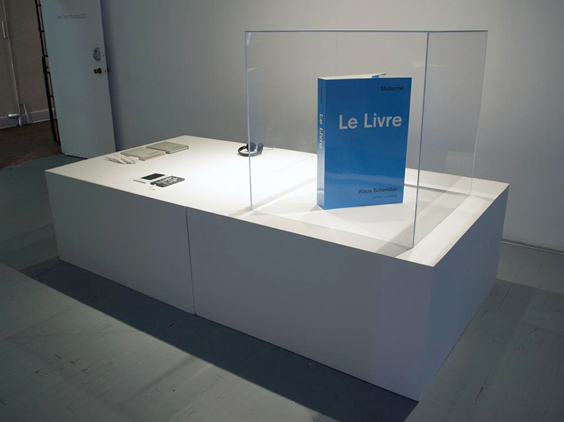
Exhibition view, from left to right: Boris Meister “Above the Cloud – Archeology of Social Networks” (2012), Sebastian Schmieg and Silvio Lorusso “56 Broken Kindle Screens” (2012), Ruth Beale “Now From Now” (2011), Klaus Scherübel “Mallarmé, The Book” (2004). Copyright Les Territoires, Montreal.
Niekolaas Johannes Lekkerkerk is an independent curator, writer and director of The Office for Curating based in Rotterdam, the Netherlands. He curated the group show Dans Cinquante Ans d’Ici (50 Years From Now), currently on view at Les Territoires in Montréal (12 March – 19 April 2014). The twelve artists collective exhibition posits the book as art object, container and concept against the backdrop of ongoing discussions addressing the potential demise of the physically bound volume. Lekkerkerk explains in his interview his urge to look into the dynamics of co-existing analog and digital formats within our current media driven society, to raise the key question: “To what extent have the changes in our relationship with information – and the formats we employ for its transmission – altered our rapport to knowledge and its production?”
M-KOS [MKOS]: How did you develop Dans Cinquante Ans d’Ici into a curatorial project?
Niekolaas Johannes Lekkerkerk [NJL]: From a personal perspective, the exhibition Dans Cinquante Ans d’Ici is the culmination of a previous exhibition cycle entitled Reading Complex, which I developed at various locations in London throughout 2012 together with curator Catherine Y. Serrano. At the time we were interested in – generally speaking – further exploring the relations between viewer-reader and image-text in the context of visual art and artistic practice. For instance, we wanted to look into the fact that we, as viewers, make a narrative reading – an ABC reading – of principally every encounter, whereas the visual evidence we “collect” in order to inform this reading is often incongruous and misplaced. We wanted to link this principle, inherent to our (over)stimulating image-culture, to by what means narrative arcs are employed in artistic practice, and how the connecting of the dots is left to the visitor, so to speak.
The group exhibition Dans Cinquante Ans d’Ici has developed some of these strands further by looking into the dynamic of co-existing analog and digital formats and mediums within our current society – how the digital is equally physical, even though, at times, it might seem overly “synthetic” or artificial, why the evolution of the book format is read linear, to be followed up by the next format in line, whereas its digital counterparts mostly mimic the material connotations of the book: the interaction between eyes and page, and the hand and fingers to hold the device and turn the pages, the spine, the cover, and so forth.
I felt an urge to research this topic further and develop its results into an exhibition presenting twelve different, sometimes conflicting outcomes, perspectives and scenarios. My preliminary conclusion might be that our social assemblage is made up and informed by an interconnected usage of a variety of the formats, which is already a more viable departure point than starting to reason in terms of a dichotomy, or even worse, a dying medium…
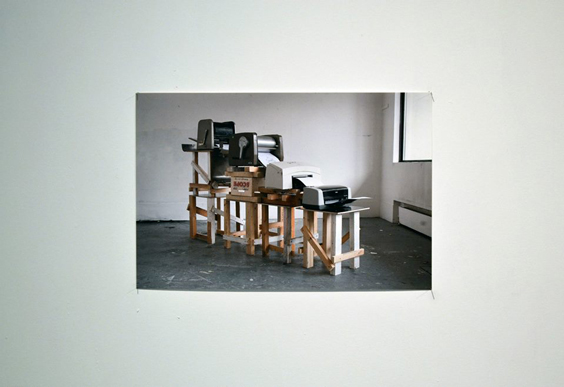
Detail of Just in Time, or a Short History of Production (2010) by Xavier Antin, courtesy of the artist. Copyright Les Territoires, Montreal.
MKOS: The title of your show projects us into the future, to question what will happen to the printed book format and our relationship with it in an era where digital literature is becoming the norm. In this exhibition, we sense an anticipated nostalgia and melancholy towards the demise of printed books, but are such feelings not the very motivation for us to preserve the practice of printing books alive?
NJL: The title for this exhibition – based on a French pop song claiming that “In fifty years from now, the word has changed” – is used to trigger the idea that the type of debate claiming a certain medium is either dead or dying is somewhat redundant, in the sense that the outcomes remain open-ended, and are seemingly infinitely postponed as the mediums function, usage and position might shift, but is normally sought to be responsive – inasmuch the medium is capable – to a certain demand. The book – either in digital or analog shape – as a container of or conveyer for information is far from, for example, the format of the cassette, as it remains one of the most efficient indexes for human interaction and engagement.
That being said, the subtitle makes mention of “the remainder of the book and other variable formats”. Here I have used the word “remainder” as to let the exhibition propose –“ both speculative and concrete – checks and balances with our present condition: to balance between “what is left of the book”, and “how is the book functioning currently”, and the fact that the book is likely “to remain”, to co-exist with other variable formats. A double position that gives leeway for one to feel sentimental, nostalgic, or melancholic, although I believe the exhibition is pointing elsewhere…
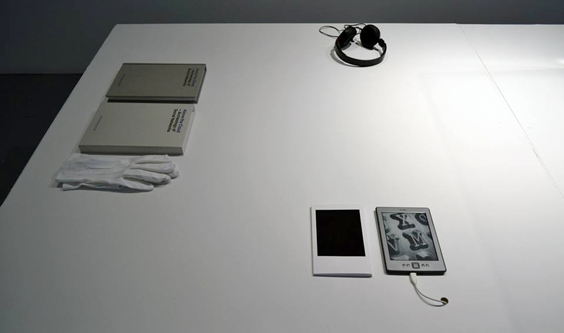
Exhibition view, from left to right: Boris Meister “Above the Cloud – Archeology of Social Networks” (2012), Sebastian Schmieg and Silvio Lorusso “56 Broken Kindle Screens” (2012), Ruth Beale “Now From Now” (2011). Copyright Les Territoires, Montreal.
MKOS: As e-books and digital publications become evermore ubiquitous, the value of printed books inevitably shifts and readjusts itself to changing demands. In this context, the piece “Variable Format” elaborates on diverse printing possibilities as well as on paper and its material expression. Boris Meister’s Above the Cloud, also brings an unexpected mass to his book (because of the use of glass for its cover) and adds a sense of preciousness to the object. Do you think the relative scarcity of physical books in the future will inevitably make them into coveted ollectibles?
NJL: Indeed, common thinking and behaviour would suggest that the book is undergoing a transformation into a luxury item and an aesthetic emblem. Not necessarily financially, but spatially, and even physically. This tendency, however, equally gives rise to an increase in and proliferation of artist books and publications, magazines, and all kinds of artistic materials that are being produced as consciously and willingly independent from the screen, ideas and projects that hinge and rely on their translation into a more sensual object – and this strand goes far beyond the idea of the limited edition…
MKOS: We could also understand the irony in this compulsion to archive a digital iteration of social media onto a bound volume, since digital storage solutions are, in fact, more vulnerable to potential damage than physical books and prone to obsolescence. This is also reflected in Sebastian Schmieg & Silvo Lorusso’s work…
NJL: Another odd example of this would be the possibility for Facebook user’s to print their timeline and create a book of their (online) posts. As most of our interactions have become exclusively digital and the materials assembled reside and dwell within digital environs, the idea to create a physical remnant seems reactionary. Here we are reminded – mostly unconsciously – that digital media are unstable, for the right reasons, most of the time, and our online legacy does not count for much in the eyes of posterity. For me, personally, this is an act of sentiment and nostalgia, and vanity, most of all.
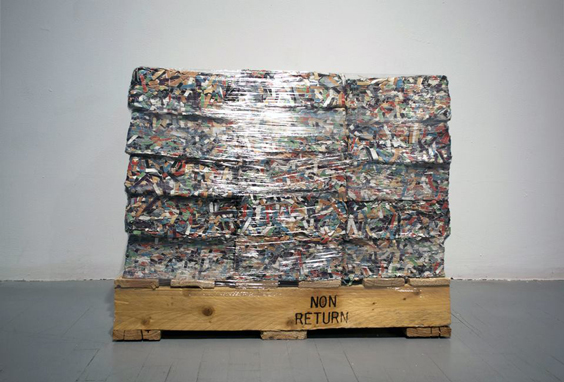
Ryan Gander, You Said I Was An Empty Page To You, 2008, courtesy of the artist and Johnen Galerie, Berlin. Copyright Les Territoires, Montreal.
MKOS: Klaus Scherubel’s Mallarmé, The Book is dedicated to Stéphane Mallarmé’s unrealised project to contain all human knowledge into one single book. Decades after his utopian ideal, H.G. Wells published his own anticipatory fiction entitled World Brain, describing an Encyclopaedia of universal information, accessible to the citizens across the globe. Now, Google is attempting a similarly grandiose project to scan and digitize every existing publication to create a totalitarian online library. But unlike Mallarmé’s poetic vision, or Wells’ socialist ideal, Google’s intentions seems more mercantilist, monopolizing in effect all this knowledge via copyright laws and undoubtedly riddled with advertisements once users eventually get to see it. Of course many positive aspects should come out of this mega-project, but it also may emerge as a real threat to our social and personal engagement with the printed books, beyond the moral obligation to keep this physical alternatives alive…
NJL: In this case we are confronted with the idea of ethics, and not only the ethics of copyright control and censorship. It seems to be the case that the Google Books project is foregrounding its idealist goal to make information and knowledge available online, to everyone. The idea that “information wants to be free”, as punned often, only applies partially in this case since major repositories – among prominent university and city libraries – are overthrown and infiltrated by Google’s “high aim” of this pun, whereas there is no mutual benefaction, both financially and functionally: the information contained in these external repositories could potentially be free, for a price paid: the relevance of these public services and the democratic treatment of its contents…
MKOS: You were born in 1988, therefore you grew up with the internet/digital revolution. How did this motivate you to work on such a project dedicated to the printed book?
NJL: The exhibition is only partially “dedicated” to the book, and although it forms a central motive and departure point the main idea was to give an insight into those formats and mediums employed in our communication- and information-driven society, and to what extent certain shifts have altered our rapport to knowledge and its production.
I am always interested in bringing certain present conditions to the fore, subjects that are so thoroughly embedded within the fabric of daily life they normally go unnoticed, or are readily agreed upon. In that, I have an inclination to think that employing curating as a tool to think through contemporary society, by means of instances from artistic practices, is a relevant and interesting way to consider how objects and entities can potentially find their inscription into contemporaneity. I, on my behalf, show and exemplify the mechanisms, the rest is left to the visitor…
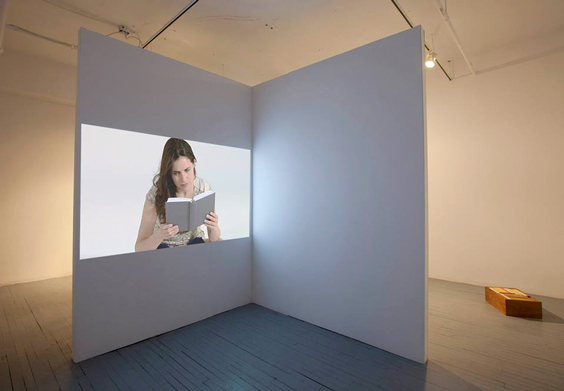
Exhibition view, from left to right: Aurélien Froment, Nina Beier and Marie Lund. Copyright Les Territoires, Montreal.
MKOS: You also curated a project that used a vinyl record, which showed for first time at the Marrakech Biennale this year. Vinyls are also succumbing to a similar fate as the printed book. Why did you choose vinyl as a principle material?
NJL: Mainly because – as an object – it is palpable and tangible, both physically and spatially: in conjunction with a sleeve this object can and should be unpacked and unfolded in another space – internalising the need for you to engage with the various materials in order to let it become active. Another relevant aspect would be the fact that you can literally see how sounds are inscribed on the support structure, in which the record serves as an intermediate. This is a rather different procedure as compared to the book, which establishes a direct relation with the reader, i.e. you do not need an electric device to distribute the sensible…
That being said, we have also made the record available for distribution and circulation for people to take responsibility over these works: an exhibition that is portable and can be shown at different times, outside of the boundaries of the time and space set by its initial iteration – a more permanent and solidified instance of an exhibition, which is so often ephemeral, but not per definition.
MKOS: What is your next project?
NJL: In April I will present a group exhibition entitled “Ways of Working, According to an Office Desk”, on the question of “How to profess, rather than how to professionalise?” in the context of working and practicing as an artist today. The exhibition will present works by Anca Benera and Arnold Estefan, Céline Berger, Dina Danish, Jakup Ferri, David Horvitz, Sally O’Reilly and Colin Perry and will be presented at Upominki in Rotterdam. ◼︎
Interviewed by Miwa Kojima
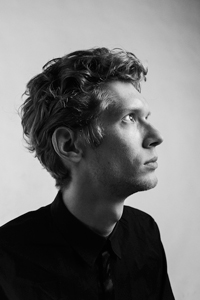
Niekolaas Johannes Lekkerkerk (b.1988, Rotterdam) works as a curator and a writer. He holds a BA in Art History and Visual Culture from the University of Utrecht, and an MA in Curating from the London Metropolitan University, delivered in conjunction with the Whitechapel Art Gallery. He has worked at a number of institutions including SMBA (Stedelijk Museum Bureau Amsterdam) and DRAF (David Roberts Art Foundation, London). In 2012 he founded The Office for Curating, which is currently based in Rotterdam. Recent exhibitions include Dans Cinquante Ans d’Ici (2014) at Les Territoires, Montreal; the Parallel Project Within the Sound of Your Voice for the Marrakech Biennale (2014); All the Pieces, Back Together (2013) at Selma Feriani Gallery, London; Shadows of a Doubt (2013), Tallinn Art Hall, Tallinn; The Great Indoors (2013), Motive Gallery, Brussels; Can’t Hear My Eyes (2013), Two in the Wave (2013), Printroom, Rotterdam; Artists of the No (2012), Projektraum Viktor Bucher, as part of Curated by_Vienna 2012. His publications include, None of the Above (2011) on curating and the curatorial in the key of fiction; ‘Untitled’ (Constants Are Changing) on the works of Felix Gonzalez-Torres (2010). He also has contributed to a number of magazines, among Art Licks, Cura. and Metropolis M. In 2012 he was the recipient of the NEON Curatorial Award at the Whitechapel Art Gallery, London, in recognition of his fiction and literature-based approach to curating. Lekkerkerk will be the curator-in-residence at Schloss Ringenberg starting from July 2014. theofficeforcurating.com
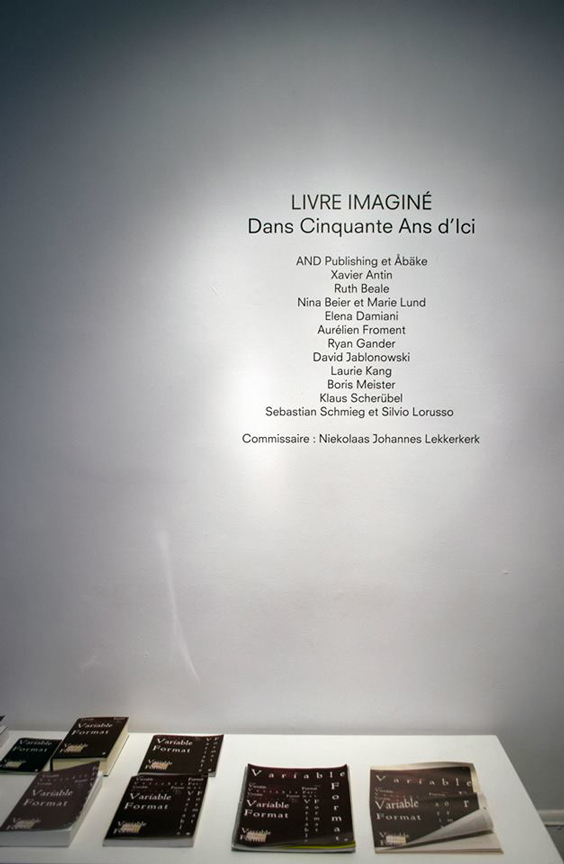
Exhibition view with detail of Variable Format (2012) by AND Publishing and Åbäke, courtesy of the artist. Copyright Les Territoires, Montreal.
Dans Cinquante Ans d’Ici
12 March – 19 April 2014
at Les Territoires, Montréal
lesterritoires.org
Curated by Niekolaas Johannes Lekkerkerk
With: AND Publishing and Åbäke, Xavier Antin, Ruth Beale, Nina Beier and Marie Lund, Elena Damiani, Aurélien Froment, Ryan Gander, David Jablonowski, Laurie Kang, Boris Meister, Klaus Scherübel, Sebastian Schmieg and Silvio Lorusso
